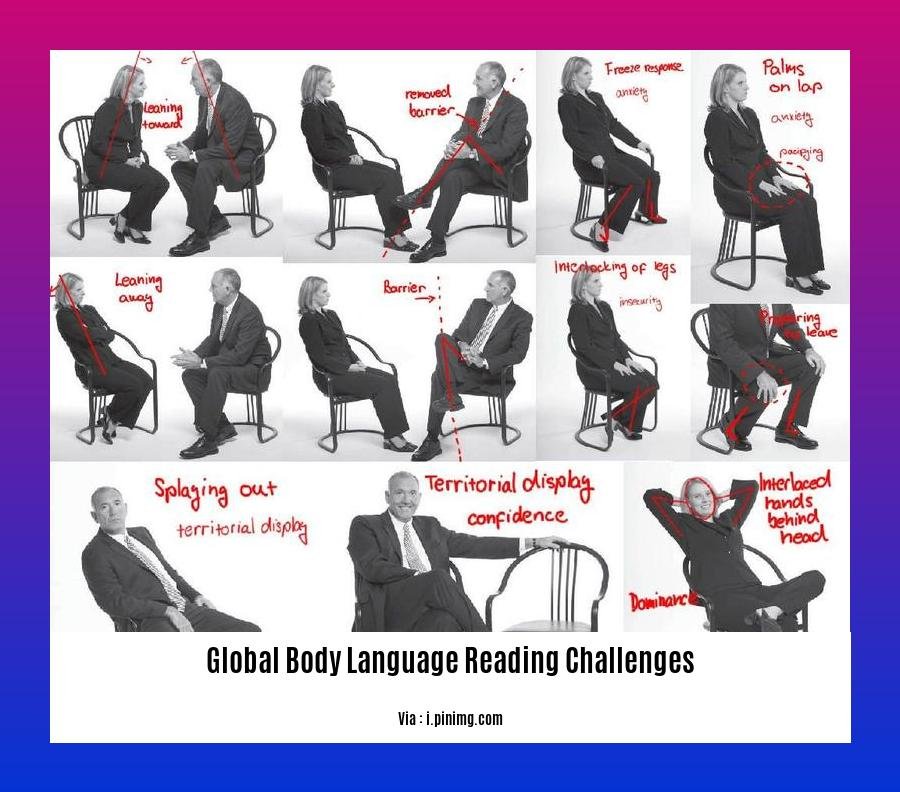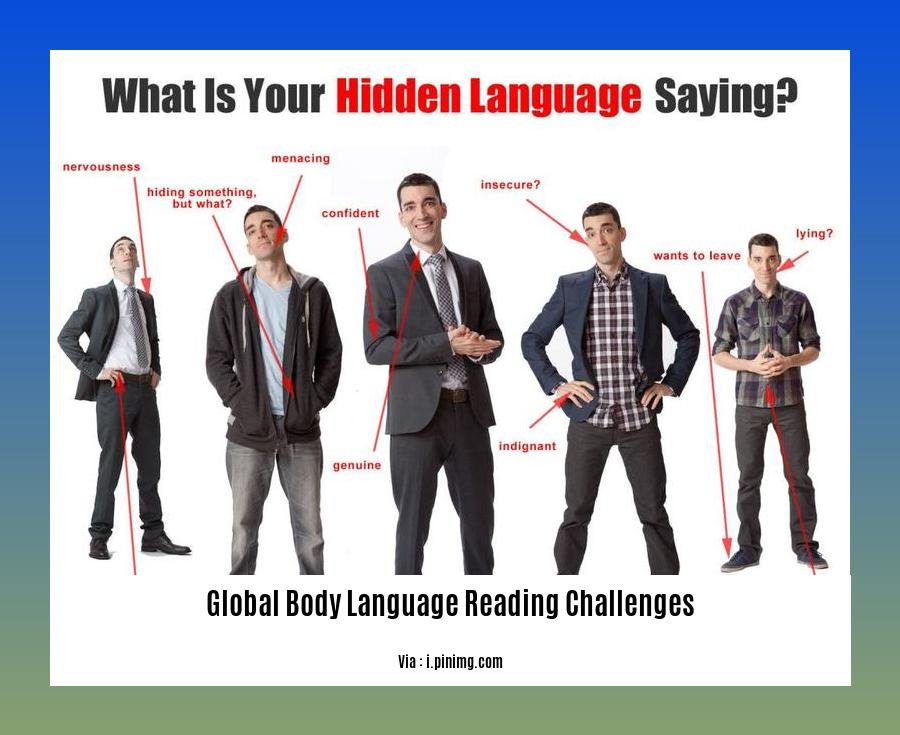In the realm of global communication, understanding body language poses unique challenges as cultural cues vary across borders. The article “Global Body Language Reading Challenges: Navigating Cultural Cues in an Interconnected World” delves into the complexities of deciphering nonverbal cues in an interconnected world, exploring the nuances, opportunities, and pitfalls of cross-cultural body language interpretation.
Key Takeaways:

- Fear can resemble the stress of lying.
- Incomplete questions can create false interpretations of body language.
- Traumatic memories evoke stress-related body language.
- Memory falters, affecting body language analysis accuracy.
- Genuine mixed emotions don’t always indicate guilt or innocence.
Global Body Language Reading Challenges
Navigating the intricacies of body language across cultures requires an astute understanding of cultural norms and nonverbal cues. Overcoming global body language reading challenges involves a comprehensive approach that encompasses cultural awareness, careful observation, and practical strategies.
Understanding Cultural Variations
Cultural influences profoundly shape body language expression. Hand gestures, facial expressions, and posture carry different meanings in different regions. For instance, the “OK” sign commonly used in the West symbolizes “zero” or “worthless” in some cultures. Recognizing these variations is crucial to avoid misinterpretations.
Observing and Interpreting Body Language
Effective body language reading involves observing and interpreting nonverbal cues. Facial expressions, gestures, and posture provide valuable insights into emotions and intentions. However, context plays a vital role. A smile, for example, may indicate happiness in one culture but embarrassment in another. Consider the overall situation and other nonverbal cues to determine the most likely interpretation.
Overcoming Challenges
Several challenges can arise in global body language reading challenges. These include:
- Incomplete or suggestive questioning techniques can lead to misleading body language interpretations.
- Recalling traumatic events may trigger stress-related body language.
- Mixed emotions can be genuine and may not indicate innocence or guilt.
To overcome these challenges, adopt the following strategies:
- Seek information from multiple sources to gain a comprehensive understanding.
- Adjust to different contexts and cultural norms.
- Consider the emotional state of individuals.
Practical Applications
Mastering global body language reading challenges offers numerous practical benefits. It enhances:
- Cross-cultural communication effectiveness
- Relationship building by fostering cultural sensitivity
- Understanding of cultural nuances to avoid misunderstandings
Become a skilled global body language reader by embracing cultural diversity, observing nonverbal cues with discernment, and employing these strategies to bridge communication gaps and build stronger connections.
When interpreting nonverbal cues between different cultures, such as those between male and female, it’s essential to be aware of cultural differences in female body language cultural differences in female body language. These variations extend to flirting as well; a gesture that may convey interest in one culture could be seen as disrespectful in another. To avoid misinterpretations, it’s crucial to understand variations in flirting by culture.
Moreover, when interacting with people from diverse ethnic backgrounds, it’s important to recognize the nuances of body language to ensure clear communication. Cross-cultural sensitivity requires an understanding of interpreting body language across ethnicities.
Overcoming Challenges in Cross-Cultural Reading
Key Takeaways:
- Acknowledge Cultural Differences: Body language varies significantly across cultures, so it’s crucial to understand the nuances of different contexts.
- Observe and Contextualize: Pay attention to facial expressions, gestures, and posture, and consider the broader cultural context to interpret cues accurately.
- Avoid Assumptions: Resist making generalizations based on isolated gestures or facial expressions; seek corroboration from other nonverbal cues and verbal communication.
- Adjust and Adapt: Be flexible in your approach and adjust your expectations based on the cultural context you’re in.
- Build Cross-Cultural Awareness: Immerse yourself in different cultures, interact with people from diverse backgrounds, and engage in active listening to develop a deeper understanding of nonverbal communication.
Relevant URL Source:
Cross-Cultural Communication: Overcoming Challenges in Global Business
Practical Applications of Body Language Reading
Key Takeaways:
- Understanding cultural variations in body language enhances cross-cultural communication and reduces misunderstandings.
- Observing and interpreting body language cues provides insights into others’ emotions, thoughts, and intentions.
- Overcoming challenges in cross-cultural body language reading requires adjusting to different contexts and seeking information from multiple sources.
- Effective body language reading fosters stronger relationships, facilitates learning, and enhances communication in global settings.
Understanding Cultural Variations
Body language gestures and expressions vary significantly across cultures. For example, a thumbs-up gesture in Western cultures conveys approval, while it may be seen as offensive in some African cultures. Understanding these cultural variations is crucial to avoid misinterpretations and facilitate effective cross-cultural communication.
Observing and Interpreting Body Language
1. Observe Body Language Cues:
- Facial expressions: Pay attention to smiles, frowns, raised eyebrows, and pursed lips.
- Gestures: Examine hand movements, arm positions, and body orientation.
- Posture: Note the way someone sits, stands, and walks.
2. Analyze Combinations of Cues:
Body language cues don’t always occur in isolation. For instance, a person with crossed arms and a stern expression may be indicating defensiveness.
Overcoming Challenges
1. Adjust to Cultural Norms:
Be aware of the cultural context and adjust your interpretations accordingly. For example, in some Asian cultures, direct eye contact may be seen as disrespectful.
2. Seek Information from Multiple Sources:
Don’t rely solely on body language for understanding. Combine it with verbal communication, facial expressions, and cultural background to get a comprehensive picture.
Practical Applications
1. Enhanced Cross-Cultural Communication:
Effective body language reading bridges cultural gaps and facilitates seamless interactions.
2. Improved Relationship Building:
Understanding others’ body language cues fosters empathy, trust, and stronger connections.
3. Facilitated Learning:
Observing body language cues helps educators gauge students’ understanding and adjust teaching methods.
Conclusion
Practical Applications of Body Language Reading empower us to navigate the complexities of global communication. By understanding cultural variations, observing body language cues, and overcoming challenges, we can harness this nonverbal language to connect, collaborate, and thrive in an interconnected world.
Citation:
The Importance of Body Language in Professional Communication
Importance of Cultural Awareness in Interpretation
Navigating the intricacies of body language in a globalized world requires an acute awareness of cultural nuances. Cultural Awareness in Interpretation is paramount for deciphering the often-subtle cues that convey diverse messages across cultures.
Understanding Cultural Variations
Body language is deeply influenced by cultural norms, values, and beliefs. Gestures that may be considered polite in one culture could be offensive in another. For instance, nodding can indicate agreement in many Western cultures, but in Bulgaria, it can signify denial.
Steps to Overcome Challenges
Overcoming global body language reading challenges involves several crucial steps:
- Educate Yourself: Immerse yourself in the customs and traditions of different cultures.
- Observe Attentively: Pay close attention to facial expressions, gestures, and posture, considering the context.
- Seek Contextual Clues: Gather information from multiple sources, such as verbal cues, surroundings, and cultural background.
- Interpret Cautiously: Avoid making hasty judgments based on isolated body language cues.
Practical Applications
Cultural awareness in body language interpretation has significant benefits:
- Enhanced Cross-Cultural Communication: Understanding cultural cues fosters effective and respectful communication across borders.
- Improved Relationship Building: Sensitivity to body language nuances can help build stronger relationships and bridge cultural divides.
- Avoidance of Misunderstandings: Recognizing cultural variations in body language prevents misinterpretations and misunderstandings.
Key Takeaways:
- Cultural norms shape body language expressions.
- Contextual cues are vital for accurate interpretation.
- Overcoming challenges requires cultural education and attentive observation.
- Cultural awareness enhances cross-cultural communication and relationship building.
- Sensitivity to body language nuances prevents misunderstandings.

FAQ
Q1: How can cultural differences impact body language interpretation?
A1: Body language signals can vary across cultures, which can lead to misinterpretations if not taken into consideration.
Q2: Why is it important to be aware of suggestive questioning techniques when interpreting body language?
A2: Suggestive questioning can influence a person’s behavior and trigger misleading body language responses.
Q3: How can memory and time affect the accuracy of body language analysis?
A3: Memory becomes less reliable over time, which can impact the accuracy of body language interpretations, especially when recalling traumatic events.
Q4: What are the limitations of using body language as a sole indicator of deception?
A4: Fear of not being believed can mimic the stress responses of a liar, and mixed emotions may not indicate guilt or innocence.
Q5: How can language barriers affect cross-cultural communication and body language interpretation?
A5: Language barriers can lead to misunderstandings and distortions in communication, making it challenging to accurately interpret body language cues.










